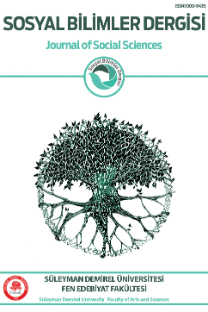Sistem Karşıtı Filmler Üzerine Feminist Bir Çözümleme: “Guguk Kuşu” Örneği
1960’lı ve 70’li yıllar, sistem karşıtı toplumsal hareketlerin yükseldiği bir dönemdir. Dönemin isyanlarını ve taleplerini kültürel ürünlerden yakalamak mümkündür. Sisteme eleştirel yaklaşan filmlerden biri olan One Flew Over the Cuckoo’s Nest (Guguk Kuşu), Ken Kesey’in 1962 yılında yayımlanan romanından uyarlanarak 1975 yılında çekilen ABD yapımı bir filmdir. Film dönemin en çok izlenen yapıtlarından biri olmuştur. Ancak filmin eleştirelliği patriyarkal sistemi teğet geçmektedir. Buradan hareketle cinsiyet körü bir sistem eleştirisinin patriyarkayı besleme yollarının neler olabileceğini açığa çıkarmak amacıyla Guguk Kuşu filmi feminist perspektifle incelenmek istenmiştir. Film, odağına aldığı akıl hastanesinin kurumsal işlevlerini ne düzeyde gerçekleştirebildiğine dair şüpheler barındırır. Bu şüpheler, sisteme karşıtlığın nedenleri olarak öne sürülür. Çalışmada öncelikle hastanenin işleyiş sisteminin patriyarkal görünümleri üzerinde durulmuştur. Ana karakterler olan Hemşire Ratched ve McMurphy arasındaki çatışmalar ile diğer karakterler toplumsal cinsiyet odağında tartışılarak analiz sonlandırılmıştır.
Anahtar Kelimeler:
Erkeklik, Feminist Film Eleştirisi, Guguk Kuşu (film), Kadınlık, Patriyarka.
A Feminist Analysis on Anti-System Movies: The Case of “One Flew Over The Cuckoo’s Nest”
The years between the 1960s and the 1970s is the era that anti-system social movements have risen. It is possible to catch the rebellions and the demands of the age from cultural products. In this context, having a critical view over the system, “One Flew Over the Cuckoo’s Nest” is a USA origin movie adapted from Ken Kesey's novel published in 1962. The movie has become one of the most highly rated movies during the age. However, the critical base of the film does not touch the patriarchal system. Thus, the “One Flew Over the Cuckoo’s Nest” movie is aimed to examine from the feminist point of view to be able to unearth the probable feeding paths of the patriarchal system by gender-blind system criticism. The movie bears doubts about the mental institution, which focuses on whether the hospital straightforwardly fulfills its institutional functions. These doubts can be put forth as the basis for anti-system regard. In this study, it is dwelt on the working mechanism of the institution initially. Subsequently, the conflicts between Nurse Ratched and McMurphy and other characters are discussed under gender-based focus.
Keywords:
Masculinity, Feminist Film Criticism, Feminity, One Flew Over the Cuckoo’s Nest (film), Patriarchy.,
___
- Bourdieu, P. (2014). Eril tahakküm. (Çev. Bediz Yılmaz). İstanbul: Bağlam.
- Connell, R. (1998). Toplumsal cinsiyet ve iktidar – toplum, kişi ve cinsel politika. (Çev. Cem Soydemir). İstanbul: Ayrıntı.
- Darbyshire, P. (1995). Reclaiming ‘bignurse’: a feminist critique of ken kesey’s portrayal of nurse ratched in one flew over the cuckoo’snest. Nursing Inquiry, 2, 198-202.
- Direk, Z. (2009). Judith Butler: toplumsal cinsiyet ve bedenin maddeleşmesi. Zeynep Direk (Ed.). Cinsiyetli Olmak – Sosyal Bilimlere Feminist Bakışlar (s. 67-84). İstanbul: Yapı Kredi.
- Donovan, J. (2015). Feminist teori. (Çev. Aksu Bora, Meltem Ağduk Gevrek vd.). İstanbul: İletişim.
- Ecevit, Y. (2013). Emek. Yıldız Ecevit ve Nadide Karkıner (Ed.). Toplumsal Cinsiyet Çalışmaları (s. 24-49). Eskişehir: Anadolu Üniversitesi.
- Francis, W. A. (1989). Of madness and machines: names in ken kesey's one flew over the cuckoo's nest. Literary Onomastics Studies, vol.16, article 14. http://digitalcommons.brockport.edu/los/vol16/iss1/14
- Hooks, B. (2014). Feminizm herkes içindir / tutkulu politika. (Çev. Ece Aydın, Berna Kurt vd.). İstanbul: bgst.
- Karabağ, M. (2019). Zeki demirkubuz filmlerindeki kadın temsillerinin feminist film eleştirisi çerçevesinde incelenmesi: c blok, masumiyet, üçüncü sayfa. Erciyes İletişim Dergisi, 6 (2), 1427-1444.
- Kesey, K. (Yönetmen). (1975). One Flew Over the Cuckoo’s Nest (Guguk Kuşu) (Film) ABD.
- Meloy, M. (2009). Fixing men: castration, impotence, and masculinity in ken kesey’s one flew over the cuckoo’s nest. The Journal of Men’s Studies, vol. 17 no. 1, 3-14.
- Mulvey, L. (1997). Görsel haz ve anlatı sineması. 25. Kare. (Çev. Nilgün Abisel). Sayı:21, 18-24.
- UKEssays. (2018). Sexism and gender roles in cuckoos nest english literature essay. https://www.ukessays.com/essays/english-literature/sexism-and-gender-roles-in-cuckoos-nest-english-literature-essay.php?vref=1
- Öğüt, H. (2009). Kadın filmleri ve feminist karşı sinema. Cogito – Feminizm, Sayı: 58, 203-217.
- Özden, Z. (2004). Film eleştirisi: film eleştirisinde temel yaklaşımlar ve tür filmi eleştirisi. Ankara: İmge.
- Öztan, E. (2015). Feminist araştırmalar ve yöntem. Feryal Saygılıgil (Hz.). Toplumsal Cinsiyet Tartışmaları (s. 271-291). Dipnot.
- Öztürk, S. R. (2011). Türkiye sinema literatüründen kadınlara bakmak. Serpil Sancar (Der.). Birkaç Arpa Boyu - 21. Yüzyıla Girerken Türkiye’de Feminist Çalışmalar Cilt: 2 (s. 679-699). İstanbul: Koç Üniversitesi.
- Reis, P. (1987). Good breast, bad breast, this is the cuckoo's nest: ken kesey and the myth of matriarchy. Journal of Feminist Studies in Religion, vol. 3, no. 2, 77-96.
- Sancar, S. (2013). Erkeklik: imkansız iktidar – ailede, piyasada ve sokakta erkekler (3. Basım). İstanbul: Metis.
- ISSN: 1300-9435
- Yayın Aralığı: Yılda 3 Sayı
- Başlangıç: 1995
- Yayıncı: Süleyman Demirel Üniversitesi, Fen-Edebiyat Fakültesi
Sayıdaki Diğer Makaleler
Dalyan Boğazında Bilinmeyen Bir Yapı: Köyceğiz - Çandır Köyü Han ve Depo-Ambar Binası
Murat Erdal DERE, Kadir PEKTAŞ
Pasarofça Müzakereleri ve Sınır Tahdidinde Yaşanan Diplomatik Krizler
Seleukeia Sidera Antik Kentin’nden Olynthos Tipi Öğütme Taşları
Konya Atlı Tramvayı ve Kent İçi Ulaşıma Etkisi (1906 – 1914)
Jean François Lyotard’ın Düşünceleri Bağlamında Postmodern Bilgi Sorunu
Geç Osmanlı ve Erken Cumhuriyet Döneminde Türk Resim Sanatında Gölge
Bir Şehir Kurucusu Olarak Seyyid Harun Veli
Hadrianopolis Antik Kenti’nden Bir Grup Erken Bizans Dönemi Sütun Başlığı
